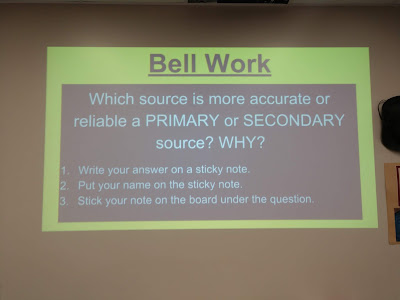I started my day today (after two snow days) with this task focused on the question... "Which source is more accurate or reliable a PRIMARY source or a SECONDARY source?
Now...this is not the first time I have asked my 7th graders this question. But we've been full force into some really cool primary sources lately...and I had a feeling they were forgetting their Historical Training from the first of the year and how IMPORTANT it is to really look at the sourcing information and WHY the document was created. What PURPOSE was it serving?
This lesson today was created to remind them of that...AND show them that "Fake News" isn't something that President Trump started talking about a few years ago. It's been around a LONG time.
So... our bell work had them answering the question, and 95% of my 7th graders said "primary sources are more accurate because they come directly from that time period."
THEN... I pass out four documents. Their task is to work together with their teams to place these in order from MOST accurate to LEAST accurate based on what they see. teams are also instructed to make sure everyone in the group understands how and why they ranked their documents.
Next... I instruct them to very quickly decide if each one is a primary or secondary source. This takes less than 30 seconds.
Now... I ask for a "spokesperson" in each group to stand. This person rotates to a new group as the "guest." Each team then explains how and why they ranked their sources to their "guest." The guest is encouraged to question their judgement. (Often times groups are very similar in ranking, but it does lead to some great conversations. After the guests thank their "hosts" for a lovely visit, they return home and we begin our class discussion. - - Side note: did you catch all the ways for social learning and interaction with this one activity? Get your kids up and moving!
First I direct the class to our bell work question. Which source is more accurate. Usually through this discussion kids start to remember that this is a "trick" question. The answer is "it depends..." we discuss this and they all start to remember how important it is to look at the source and the purpose of the document.
Then I shock them with the news...that ALL FOUR of these documents are primary sources. We talk about how important it is to look at the purpose and how they're going to spend some time analyzing the advertisement poster.
The worksheet guides them through the poster looking at the audience, pulling out important information, and realizing some misleading information. At the end, 7th graders have to rank the accuracy of the poster from 1-10 and back up their reasoning with evidence that they encountered.
I love this lesson for many reasons. One is just the timing of it. I'm able to review the importance of sourcing a document, historical thinking skills, primary and secondary sources, and touch on how these skills were just as important in the late 1800s as they are now.






